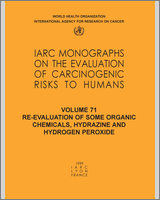NCBI Bookshelf. A service of the National Library of Medicine, National Institutes of Health.
IARC Working Group on the Evaluation of Carcinogenic Risks to Humans. Re-evaluation of Some Organic Chemicals, Hydrazine and Hydrogen Peroxide. Lyon (FR): International Agency for Research on Cancer; 1999. (IARC Monographs on the Evaluation of Carcinogenic Risks to Humans, No. 71.)
Data were last reviewed in IARC (1976) and the compound was classified in IARC Monographs Supplement 7 (1987).
1. Exposure Data
1.1. Chemical and physical data
1.1.1. Nomenclature
- Chem. Abst. Serv. Reg. No.: 2443-39-2
- Systematic name: cis-3-Octyl-oxiraneoctanoic acid
1.1.2. Structural and molecular formulae and relative molecular mass

1.1.3. Physical properties (for details, see IARC, 1976)
- (a) Melting-point: 59.5–59.8°C
- (b) Conversion factor: mg/m3 = 12.29 × ppm
1.2. Production and use
cis-9,10-Epoxystearic acid is produced only in small quantities for research purposes, but it can occur in seed oils (e.g., sunflower) upon prolonged storage (IARC, 1976).
2. Studies of Cancer in Humans
No data were available to the working group.
3. Studies of Cancer in Experimental Animals
cis-9,10-Epoxystearic acid was tested for carcinogenicity in mice by skin application and subcutaneous injection, and in rats by subcutaneous injection. No significant increase in the incidence of tumours was associated with treatment (IARC, 1976).
4. Other Data Relevant to an Evaluation of Carcinogenicity and its Mechanisms
4.1. Absorption, distribution, metabolism and excretion
4.1.1. Humans
9,10-Epoxystearic acid has been detected in human urine at concentrations of about 2 nmol/L (Ulsaker & Teien, 1995), probably occurring as a result of the oxidation of unsaturated fatty acid by cytochrome P450 (Laniado-Schwartzman et al., 1988).
4.1.2. Experimental systems
No data were available to the Working Group.
4.2. Toxic effects
4.2.1. Humans
No data were available to the Working Group.
4.2.2. Experimental systems
Daily oral doses of cis-9,10-epoxystearic acid of up to 250 mg/kg bw administered by gavage to male and female Sprague-Dawley rats did not affect growth rate, food consumption, organ weights, haematology, blood chemistry or histology. Deaths which occurred during the experiment were not substance-related, but the result of mechanical injury during dosing (Chu et al., 1980).
4.3. Reproductive and developmental effects
No data were available to the Working Group.
4.4. Genetic and related effects
4.4.1. Humans
No data were available to the Working Group.
5. Evaluation
No epidemiological data relevant to the carcinogenicity of cis-9,10-epoxystearic acid were available.
There is inadequate evidence in experimental animals for the carcinogenicity of cis-9,10-epoxystearic acid.
Overall evaluation
cis-9,10-Epoxystearic acid is not classifiable as to its carcinogenicity to humans (Group 3).
6. References
- Chu I., Villeneuve D.C., Nestmann E.R., Douglas G., Becking G.C., Lough R., Matula T.I. Subacute toxicity and mutagenicity of cis-9,10-epoxystearic acid. Bull. environ. Contam. Toxicol. 1980;25:400–403. [PubMed: 7426789]
- IARC (1976) IARC Monographs on the Evaluation of Carcinogenic Risk of Chemicals to Man, Vol. 11, Cadmium, Nickel, Some Epoxides, Miscellaneous Industrial Chemicals and General Considerations on Volatile Anaesthetics, Lyon, pp. 153–156. [PubMed: 992654]
- IARC (1987) IARC Monographs on the Evaluation of Carcinogenic Risks to Humans, Supplement 7, Overall Evaluations of Carcinogenicity: An Updating of IARC Monographs Volumes 1 to 42, Lyon, p. 63. [PubMed: 3482203]
- Laniado-Schwartzman M., Davis K.L., McGiff J.C., Levere R.D., Abraham N.G. Purification and characterization of cytochrome P-450-dependent arachidonic acid epoxygenase from human liver. J. biol. Chem. 1988;263:2536–2542. [PubMed: 3123495]
- Ulsaker G.A., Teien G. Identification of 9,10-epoxyoctadecanoic acid in human urine using gas chromatography-mass spectrometry. Biomed. Chromatogr. 1995;9:183–187. [PubMed: 8520208]
- PubMedLinks to PubMed
- Review Hexamethylphosphoramide.[IARC Monogr Eval Carcinog Risk...]Review Hexamethylphosphoramide.. IARC Monogr Eval Carcinog Risks Hum. 1999; 71 Pt 3(PT 3):1465-81.
- Dichloroacetonitrile.[IARC Monogr Eval Carcinog Risk...]Dichloroacetonitrile.. IARC Monogr Eval Carcinog Risks Hum. 1999; 71 Pt 3(PT 3):1375-9.
- Review 1,1-Dimethylhydrazine.[IARC Monogr Eval Carcinog Risk...]Review 1,1-Dimethylhydrazine.. IARC Monogr Eval Carcinog Risks Hum. 1999; 71 Pt 3(PT 3):1425-36.
- Review Dichloroacetylene.[IARC Monogr Eval Carcinog Risk...]Review Dichloroacetylene.. IARC Monogr Eval Carcinog Risks Hum. 1999; 71 Pt 3(PT 3):1381-7.
- Review beta-Propiolactone.[IARC Monogr Eval Carcinog Risk...]Review beta-Propiolactone.. IARC Monogr Eval Carcinog Risks Hum. 1999; 71 Pt 3(PT 3):1103-18.
- cis-9,10-Epoxystearic acid - Re-evaluation of Some Organic Chemicals, Hydrazine ...cis-9,10-Epoxystearic acid - Re-evaluation of Some Organic Chemicals, Hydrazine and Hydrogen Peroxide
- Decabromodiphenyl oxide - Re-evaluation of Some Organic Chemicals, Hydrazine and...Decabromodiphenyl oxide - Re-evaluation of Some Organic Chemicals, Hydrazine and Hydrogen Peroxide
- Dichloromethane - Re-evaluation of Some Organic Chemicals, Hydrazine and Hydroge...Dichloromethane - Re-evaluation of Some Organic Chemicals, Hydrazine and Hydrogen Peroxide
- Chlorodibromomethane - Re-evaluation of Some Organic Chemicals, Hydrazine and Hy...Chlorodibromomethane - Re-evaluation of Some Organic Chemicals, Hydrazine and Hydrogen Peroxide
- Diglydicyl resorcinol ether - Re-evaluation of Some Organic Chemicals, Hydrazine...Diglydicyl resorcinol ether - Re-evaluation of Some Organic Chemicals, Hydrazine and Hydrogen Peroxide
Your browsing activity is empty.
Activity recording is turned off.
See more...
